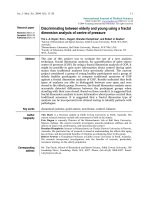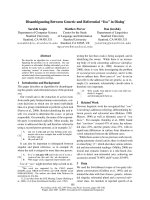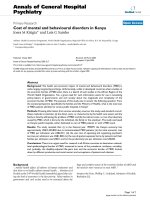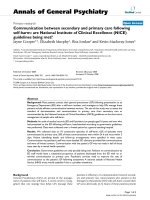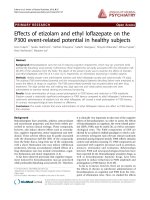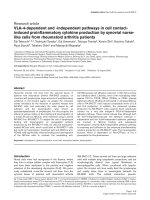Báo cáo y học: " Distinction between induction and maintenance dosing in continuous renal replacement therapy" pot
Bạn đang xem bản rút gọn của tài liệu. Xem và tải ngay bản đầy đủ của tài liệu tại đây (109.08 KB, 2 trang )
In their excellent review of dosing continuous renal
replacement therapy (CRRT), Dr Prowle and colleagues
concluded that patients should be prescribed 20 to
25 ml/kg/h [1]. However, by averaging CRRT dose over
time, studies in this area obfuscate the benefi ts of appro-
priately higher dose therapy early in the course of illness,
potentially misguiding clinicians into blindly adopting a
‘one-size-fi ts-all’ approach and consequently prescribing
inadequate doses in life-threatening emergencies. To take
a crude example, it would be inappropriate to prescribe
20 ml/kg/h CRRT in a patient with serum potassium
9 mmol/L. Rather, the highest possible dose of CRRT
should be initially prescribed to maximize solute
clearance. is depends on the maximum circuit fl ow
permitted by the access catheter, which in turn deter-
mines the maximum dose, assuming that the
counter current fl ow to blood fl ow ratio should be <0.3
with diff usive CRRT, or a fi ltration fraction with
convective therapy <0.2 [2]. As the potassium level falls,
the dose can be lowered to more conventional levels.
Parallels could be drawn to general anaesthesia, where
induction and maintenance are two distinct phases with
diff erent requirements. CRRT prescription could simi lar ly
be conceptualized as ‘induction’, where life-threatening
abnor malities are corrected quickly with high-dose therapy,
then ‘maintenance’ where solute clearance is achieved with
more temperate doses (for example, 20 to 25 ml/kg/h) to
avoid complications such as hypo phos phataemia.
It seems unlikely that this issue will be the subject of
prospective research. Yet the principle that faster correc-
tion of life-threatening abnormalities leads to better
patient outcomes seems both practical and intuitive.
© 2010 BioMed Central Ltd
Distinction between induction and maintenance
dosing in continuous renal replacement therapy
Graeme MacLaren*
See related review by Prowle et al., />LETTER
Authors’ response
John R Prowle and Rinaldo Bellomo
We thank Dr MacLaren for his comments. We agree that
such ‘induction’ therapy is mandatory in situations of
severe hyperkalemia (>8.0 mmol), especially when on-
going potassium release is taking place (for example,
rhabdomyolysis). Although such reasoning and thera-
peutic adjustment seemed obvious to us, we agree that
making them explicit is important.
We would also like to emphasize several important
aspects of adjustments to unique cases. First, avoidance
of often ineff ective and delayed interventions in critically
ill patients with severe acute kidney injury [3] and early
CRRT as applied in the RENAL (Randomised Evaluation
of Normal versus Augmented Level of Replacement
erapy) trial [4-6] are key to preventing such life-
threaten ing events in the fi rst place. In this regard, in the
RENAL trial, only 6 out of 1,454 (0.4%) patients with
baseline electrolyte values had a potassium level
>8 mmol/L. Second, faster solute removal can be
achieved by the application of modifi ed dialytic tech-
niques that deliver full equilibration between plasma fl ow
and dialysate fl ow and much greater solute clearance [7].
ird, the concept of ‘induction’ applies to volume
control as well: in a patient with pulmonary edema or
receiving large amounts of blood products, the intensity
of volume removal should be adjusted accordingly.
Finally, however, also a word a caution: in the RENAL
trial, three patients suff ered from disequilibrium syn-
drome because of too rapid solute removal. In patients
with very high concentrations of azotemic markers,
overly intensive solute removal can be detrimental.
Similarly, in patients with marked hyper- or
hyponatremia, rapid normali zation can be dangerous and
induce cerebral edema or demyelination.
*Correspondence:
Cardiothoracic ICU, National University Hospital, 5 Lower Kent Ridge Road,
Singapore 119074
MacLaren Critical Care 2011, 15:419
/>© 2011 BioMed Central Ltd
In the end, for RRT as well as every other medical
therapy, there is no substitute for a trained, educated,
committed, diligent and thoughtful physician.
Abbreviations
CRRT, continuous renal replacement therapy; RENAL, Randomised Evaluation
of Normal versus Augmented Level of Replacement Therapy.
Competing interests
The author declares that he has no competing interests.
Published: 26 April 2011
References
1. Prowle JR, Schneider A, Bellomo R: Clinical review: Optimal dose of
continuous renal replacement therapy in acute kidney injury. Crit Care
2011, 15:207.
2. Ricci Z, Ronco C: Dose and e ciency of renal replacement therapy:
Continuous renal replacement therapy versus intermittent hemodialysis
versus slow extended daily dialysis. Crit Care Med 2008, 36:S229-237.
3. Bagshaw SM, Delaney A, Haase M, Ghali WA, Bellomo R: Loop diuretics in the
management of acute renal failure: a systematic review and meta-
analysis. Crit Care Resusc 2007, 9:60-68.
4. The RENAL Study Investigators: The RENAL (Randomised Evaluation of
Normal vs. Augmented Level of Replacement Therapy) study: statistical
analysis plan. Crit Care Resusc 2009, 11:58-66.
5. RENAL Study Investigators: Renal replacement therapy for acute kidney
injury in Australian and New Zealand intensive care units: a practice
survey. Crit Care Resusc 2008, 10:225-230.
6. The RENAL Replacement Therapy Study Investigators: Intensity of
continuous renal replacement therapy in critically ill patients. New Engl J
Med 2009, 361:1627-1638.
7. Bellomo R, Baldwin I, Fealy N: Prolonged intermittent renal replacement
therapy in the intensive care unit. Crit Care Resusc 2002, 4:281-290.
doi:10.1186/cc10137
Cite this article as: MacLaren G: Distinction between induction and
maintenance dosing in continuous renal replacement therapy. Critical Care
2011, 15:419.
MacLaren Critical Care 2011, 15:419
/>Page 2 of 2
